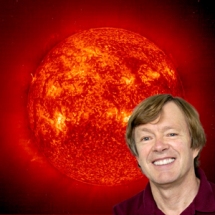Spotlight: NJIT Astronomer Receives First Board of Overseers Excellence in Research Prize and Medal
 April 2008
April 2008
The NJIT Board of Overseers and NJIT President Robert A. Altenkirch presented to internationally acclaimed solar astrophysicist Philip R. Goode the first NJIT Excellence in Research Prize and Medal on March 26, 2008. The awards are presented in recognition of a sustained record of contributions that have enhanced NJIT’s reputation.
“The award’s purpose is to elevate the image of research on campus and in the community,” said Emil Herkert, chair of the NJIT Board of Overseers. “Many professors at NJIT do notable work and we thought it long overdue that the research of these unique individuals be celebrated on the campus and in the region.” The NJIT Board of Overseers serves as the governing body for the NJIT Foundation and provides a key advisory link with a wide range of organizations in the business community.
Goode, who has led a five-year project to build the world’s most capable 1.6-meter solar telescope at Big Bear Solar Observatory, is distinguished professor of physics and director of the Center for Solar-Terrestrial Research which manages the observatory. NJIT assumed leadership of Big Bear in 1997. The observatory is located high in a mountain lake in southern California and was originally developed in 1969 by California Institute of Technology. Big Bear is one of the world’s leading observatories focused on advancing knowledge of the Sun, the largest known star in the universe.
Building the New Solar Telescope
The telescope will feature the world’s largest solar aperture. It will feed a high-order adaptive optics system, which in turn will feed the next generation of technologies for measuring magnetic fields and dynamic events using visible infrared light. A parallel computer system for real-time image enhancement will highlight the new instrument.
The magnitude of the new off-axis solar telescope—with three times the resolution of the older one—will enable Goode to probe the fundamental scale of the Sun’s dynamic magnetic fields. These fields are of great interest to solar physicists because they can cause storms—often referred to as solar flares—that destroy satellites and disrupt the power grid and telecommunications.
Goode has studied for many years the oscillating waves of the Sun’s atmosphere, known as helioseismology. Goode’s research has also focused on magnetic fields. He is expert at combining BBSO ground-based data with satellite data to determine dynamic properties of the solar magnetic fields. His other areas of interest include working to place a lower limit on solar irradiance and to probe the solar interior. Such studies impact scientists’ understanding and ability to predict space weather.
Tracking Unexpected Climate Changes
Since 1998, Goode has focused on climate studies in which the Earth’s large-scale reflectance has been measured using earthshine. He and BBSO researchers have spent time modeling the Earth’s reflectivity using satellite cloud cover and found appreciable decadal variation of reflectance due to cloud changes. BBSO is building a global network to measure the Earth’s global reflectance and spectrum.
Goode has played a major role increasing the strength of the university’s solar physics program, which has trained 24 current and past post-doctoral fellows. Twelve of these Fellows now hold faculty/national center tenure-track positions. The observatory, itself, has also flourished in size and stature. Staff has expanded from 4 to 40 individuals and the annual budget, supported solely by competitive federal grants, has risen from under $500,000 in 1997 to more than $5 million today.
Philip Goode's Presentation: "New Research Horizons: New Solar Telescope in Big Bear Solar Observatory" (PDF)

